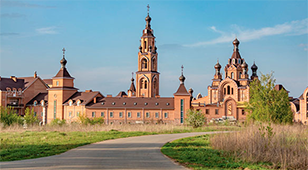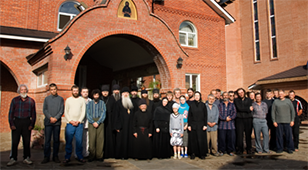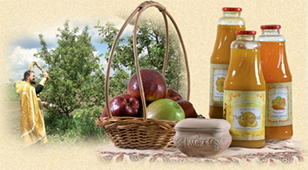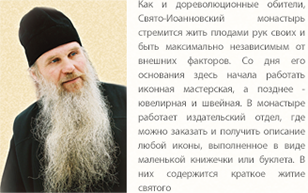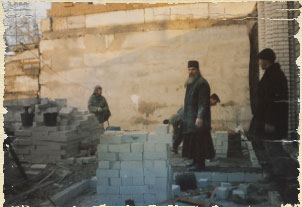Made in the monastery
The most important production of the monastery is the icon workshops. Orthodox Art is very different from the art of the mundane, especially modern. Its goal is to reveal the beauty of the world created by God as fully as possible. After all, the natural human craving for beauty is nothing like longing for the lost beauty of paradise.
![]()
"Churches are decorated with icons. Icons are not a simple image of some person or event. The icon is a symbol of the unseen. If we see the appearance of Christ and His saints, the icon should represent their internal appearance ? their holiness... The icon is not a portrait, the portrait depicts only earthly human form, the icon also shows his internal state. One cannot write an icon, depicting only the outer shape of the body, it should represent invisible exploits and the heavenly glory should shine at it. This can be made perfectly by the person who is living a spiritual life, and to whom the livings of the saints are clear and close to. Therefore, our ancient painters have always prepared for that fasting and praying. So many icons written in such way got the miraculous power given by the God"? Saint John of Shanghai wrote about icons.
Our masters follow the Orthodox tradition, in the studio at work intervals monks and novices read prayers, all work on the conscience, with reverence.
Another feature of the orthodox masters is that they do not see their work as a commodity for sale. The end result is primarily the way to bring immutable gospel truth to other people.
In the monastery products are made in such way to correspond as much as possible to their high destiny: nominal and family icons, home iconostases and small road icons are made in order to make convenient to pray on the way to the patron saint or the Blessed Virgin Mary. Also a brief description of the life of the saint and prayer are attached to each icon.
You can see the CATALOG OF ICONS, and order any loved sacred image.
Since ancient times in Russia monastic cloister owned land plots treated by fraternity or peasants, who carried out all sorts of works for monasteries according to charters (contracts). Part of the crop was to feed the inhabitants, and the surplus was sold to maintain the monastery.
Monasteries' products were always in a special demand. No wonder the old were saying: "Monastic means good." Monastic products always had really excellent quality. It was connected with the special treatment of the monks to work, as one of the means of salvation.
But the main reason was that the monks dedicated their work to God." The orthodox attitude to work does not also tolerate wickedness. Do for your neighbor as for the Lord ? this is the basic principle of any Orthodox doing.
In 2010 the monastery received a few acres of apple orchards. It made it possible to organize the production of so-called living juices under the brand "the gardens of St. John."
In the monastery gardens only environmentally friendly methods of fertilizing plants and protecting them from pests are used, and conditions of storage and processing of fruits are selected on the basis of the maximum preservation of their useful, God-given properties.
In addition, work on the ground is one of the important links in the social rehabilitation of the disadvantaged. Communing with nature helps to heal mental wounds quickly, to return a sense of the unity of the person and all that the Lord has made.
In the monastery everybody tries to make a person realize his creative potential for the glory of the Lord.
